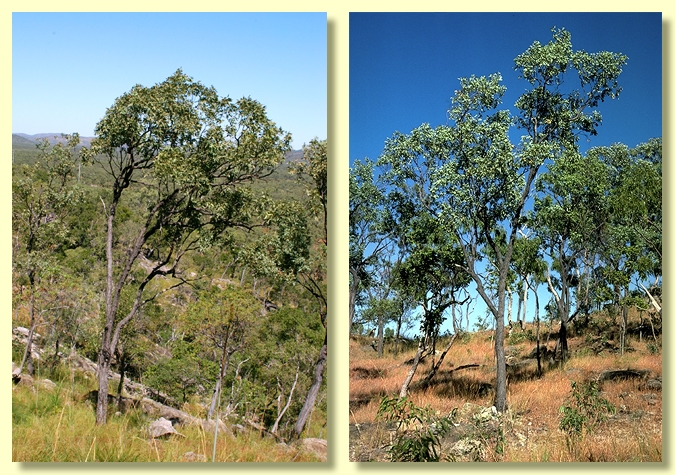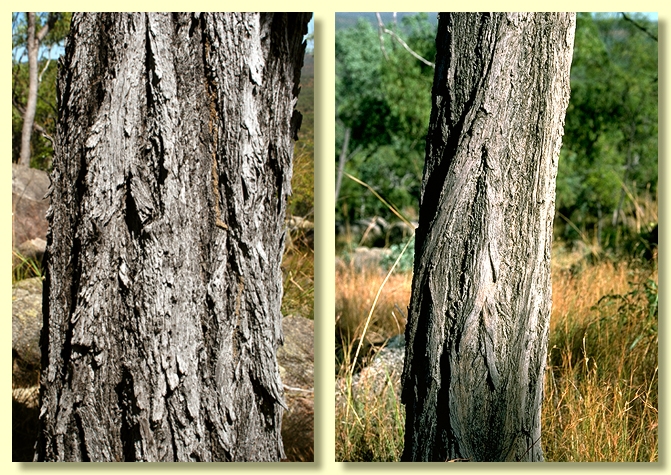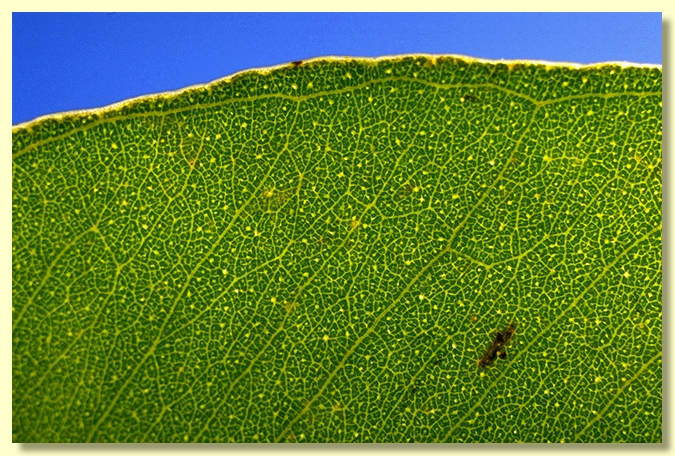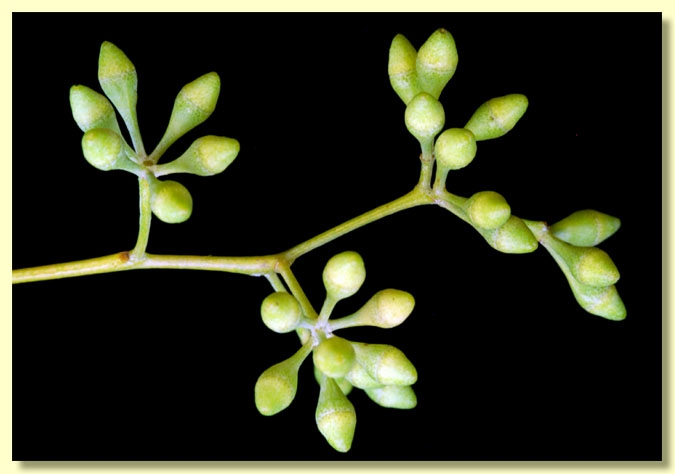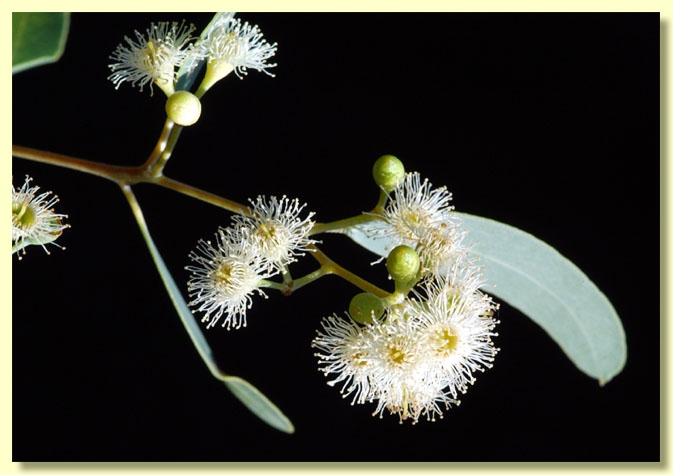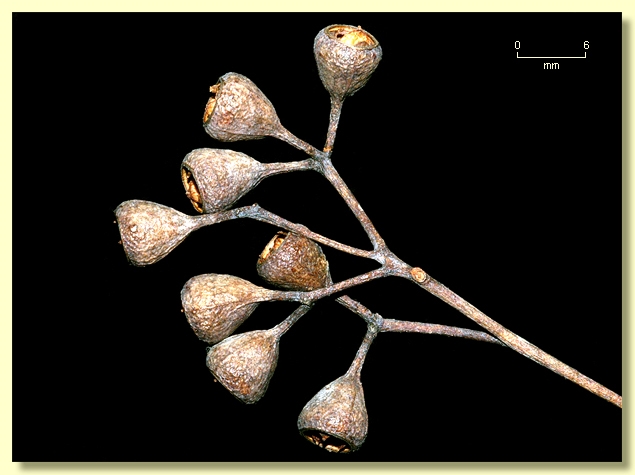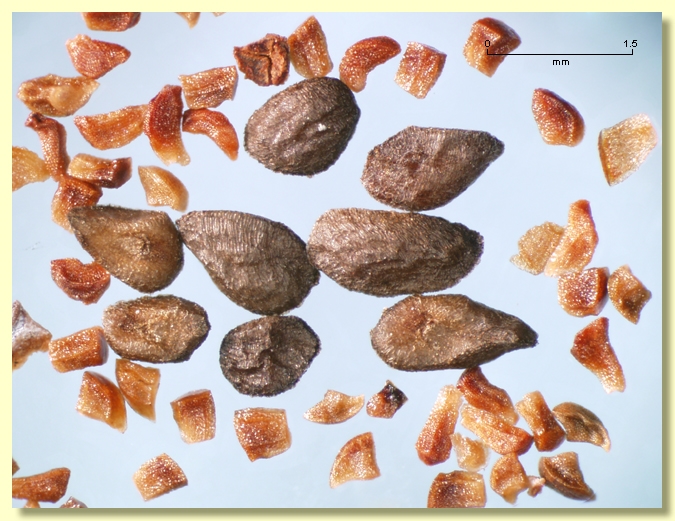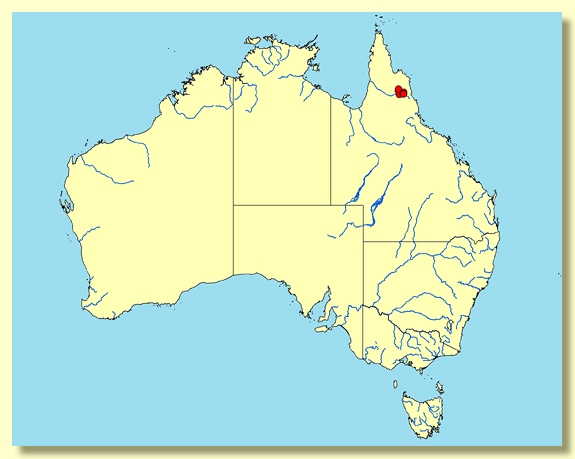Euclid - Online edition
Eucalyptus staigeriana
Eucalyptus | Symphyomyrtus | Adnataria | Apicales | Siderophloiae | Subglaucae
Eucalyptus staigeriana F.Muell. ex F.M.Bailey, Syn. Queensland Fl. 176 (1883).
T: Queensland: Cooktown, Palmer River, P.A.Sellheim s.n.; holo: BRI; iso: NSW.
Eucalyptus crebra var. citrata F.Muell., Eucalyptographia 5: t. 3 (1880). T: Queensland: Palmer River, F.M.Bailey s.n.; holo: BRI; iso: MEL, NSW.
Tree to 12 m tall. Forming a lignotuber.
Ironbark to small branches, dark grey or black.
Juvenile growth (coppice or field seedlings to 50 cm): stem rounded or square in cross-section, sometimes glaucous; juvenile leaves opposite for many nodes before becoming alternate, petiolate, ovate, 3.8–8 cm long, 2–4.5 cm wide, grey-green to glaucous.
Adult leaves alternate, petiole 0.4–1.5 cm long; blade ovate to broadly lanceolate to lanceolate, 4–11 cm long, 1.2–3.2 cm wide, base rounded to tapering to petiole, concolorous, dull, grey-green to glaucous, side-veins at an acute or sometimes wider angle to midrib, densely reticulate, intramarginal vein parallel to and just within margin, oil glands mostly intersectional. Lemon-scented.
Inflorescence terminal compound or axillary compound or axillary single umbels, peduncles 0.7–1.6 cm long, buds 7 per umbel, pedicels 0.2–0.6 cm long. Mature buds obovoid to fusiform to ovoid, 0.6–0.7 cm long, 0.3–0.4 cm wide, smooth, scar present, operculum conical to beaked, stamens usually irregularly flexed, anthers adnate, cuboid, dehiscing by broad lateral pores or slits, style long, stigma blunt or pin-head shaped, locules 3 or 4, the placentae each with 4 vertical ovule rows. Flowers white.
Fruit on pedicels 0.3–0.8 cm long, cup-shaped, sometimes glaucous, 0.4–0.7 cm long, 0.4–0.7 cm wide, disc descending, valves 3 or 4, near rim level or enclosed.
Seeds brown, 1.2–2 mm long, ovoid or flattened-ovoid or pointed at one end, dorsal surface shallowly pitted, hilum ventral.
Cultivated seedlings (measured at ca node 10): cotyledons reniform to oblong; stems square in cross-section; leaves always petiolate, opposite for ca 8 nodes then alternate, lanceolate, 4.5–8 cm long, 2–2.6 cm wide, base tapering, dull, grey-green to glaucous.
Flowering has been recorded in February and December.
A small ironbark tree restricted to hilly country in the Maytown – Palmer River – Maitland Downs area of Cape York Peninsula, North Queensland. E. staigeriana is easily distinguished from all other ironbarks by the strong smell of lemon in its crushed leaves. It is further characterised by its ovate, grey-green to glaucous juvenile leaves, its petiolate, lanceolate to broadly lanceolate to ovate, grey-green to glaucous adult leaves, buds with a conical to beaked operculum and small cup-shaped fruit. It is very closely related to E. whitei and morphologically there is not a lot separating the two species. E. whitei tends to be more consistently glaucous in the buds and fruit.
Because of the strong lemon smell in its crushed leaves, E. staigeriana should not be confused with any other ironbark.
Eucalyptus cullenii and possibly E. crebra are the only other ironbarks growing close to E. staigeriana. Both can be separated by their bud and fruit shape. E. cullenii has more or less orbicular buds with a rounded operculum and fruit with a broad flat disc. E. crebra has small buds with a rounded to bluntly conical operculum while E. staigeriana has buds with an acute operculum and fruit with a narrow descending disc.
MORE ABOUT IRONBARKS
Eucalyptus staigeriana: after Karl Theodore Staiger (1833–1888). In 1873, Karl Staiger was appointed Government Analytical Chemist and Custodian of the Brisbane Museum. In addition to his analytical duties, the pharmaceutical importance of poisonous plants was another area of interest. He was also very interested in the essential oils of eucalypts and assisted F.M. Bailey in an illustrated monograph on Queensland grasses published in 1878.

